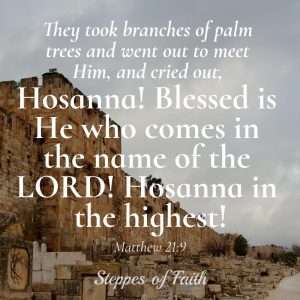
“The next day, a great multitude that had come to the [Passover] feast, when they heard that Jesus was coming to Jerusalem, took branches of palm trees and went out to meet Him, and cried out, ‘Hosanna! Blessed is He who comes in the name of the LORD! The King of Israel!’” Matthew 12:12-13
If you have ever seen a movie or documentary depicting Jesus entering Jerusalem on Palm Sunday, you undoubtedly realized why the Bible calls it The Triumphant Entry. It’s a grand and ceremonious scene. The sun is shining, the crowd is massive, majestic music is playing, palm leaves are waving everywhere, and the people are repeatedly shouting, “Hosanna! Hosanna in the highest!” It’s a beautiful moment in Jesus’ life.
But, did you notice the gate He goes through to enter the city?
At first, you might wonder why a dusty old gate would have any significance. It’s just a way to get into the city, right? It’s true that it was one way to get into Jerusalem in Jesus’ time. One of eleven, in fact. But, have you ever thought about why Jesus chose that one gate in particular?
It turns out the gate Jesus entered through on His way to the cross later that week has some significant historical and Biblical meaning that fulfills Old Testament prophecy as well as forecasts the future.
A Brief History Lesson
When Nehemiah built the gates of Jesus’ time, he gave each of them a name:
- Muster Gate
- Dung Gate
- Water Gate
- Valley Gate
- Essene Gate
- Fountain Gate
- Horse Gate
- Sheep Gate
- Fish Gate
- Old Gate
- East Gate
Currently, there are only eight gates to the Old City of Jerusalem remaining and only seven of them are in use. Most of the gates were rebuilt over the top of the original first-century gates in the 1500s after the present city wall was constructed not by the Jews or Christians, but by the Muslim ruler Suleiman the Magnificent of the Ottoman Empire in 1538 AD.
The East Gate is the oldest gate in Jerusalem and likely the one Jesus used on Palm Sunday since it had the most direct entrance to the original Temple. It was the one He could see from the Mount of Olives where He prayed, and on a clear, sunny day He could see directly into the Temple. Like the others, the gate we see today was built over the original gate which was destroyed by the Romans in 70 AD.
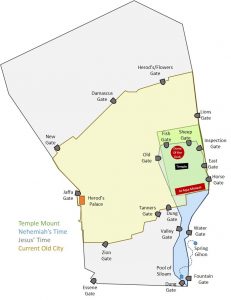
Because of its proximity to the Temple, the East Gate has become very important (and controversial) to Jews, Muslims, and Christians alike. Here’s why.
According to Jewish literature, the East Gate is where the Temple Messenger passed through on the way to taking a sacrificial lamb to the desert. It also remains as an indication of their belief of where the Messiah (who is yet to come) will re-enter the city on Yom Kippur. For Muslims, they believe the East Gate is where Allah received his final judgement and is the site of future resurrection. No doubt they also remember who built the current city wall.
For Christians, the East Gate is where Jesus made His Triumphant Entry (John 12:12-15). It is likely also the gate He exited through to pray in the Garden of Gethsemane the night of His arrest (Matthew 26:30,36), and the one He passed through 40 days after His resurrection when the disciples accompanied Him to the Mount of Olives before His last ascension into Heaven (Acts 1:9-12).
The Gate’s Biblical Prophecy
The Bible records in Acts 1:10 two angels standing with the disciples as they watched Jesus ascend into the clouds. After a moment of standing there, the angels reassure the disciples that Jesus will return to the earth the same way He was taken. Most scholars interpret this to mean that Jesus will return at the Mount of Olives, and the Jews believe it will happen during Passover, which has Biblical merit.
But, some early church founders put the angels’ words together with the prophecy found in Ezekiel 43:1-5 where Ezekiel saw the glory of God returning to the Temple “through the gate facing east” and filling the Temple again. Seleiman the Magnificent so strongly believed the prophecy that he sealed up the gate he built only three years earlier to prevent Jesus from coming. The gate has remained sealed ever since.
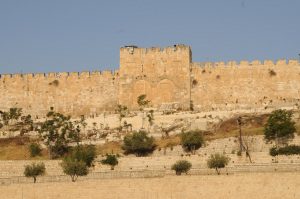
Suleiman also created a cemetery just outside the gate in the Kidron Valley as an extra layer of precaution in the belief that the Messiah would never step foot in such a place.
What Suleiman didn’t know was that he was fulfilling another prophecy found in Ezekiel 44:1-2 in which the Lord says, “This gate is to remain shut. It must not be opened; no one may enter through it. It is to remain shut because the Lord, the God of Israel, has entered through it.”
Isn’t the Bible cool?
Why Else the East Gate is Significant
The fact that Jesus chose the East Gate to make His triumphant entry into Jerusalem on Palm Sunday is significant enough. But, did you know that the East Gate also had four other names?
Though it is formally called the East Gate, it is also known as the Golden Gate, the Gate of Eternal Life, the Mercy Gate, and sometimes the Beautiful Gate. The Beautiful Gate is the only one specifically mentioned in the Bible. This very ornate gate located just inside the East Gate was where Peter and John healed a lame man in Acts 3:1-2,
“Now Peter and John went up together to the Temple at the hour of prayer, the ninth hour, and a certain man lame from his mother’s womb was carried whom they laid daily at the gate of the temple which is called Beautiful to ask alms from those who entered the temple.”
No matter what you want to call it, each name points to the glory of Jesus Christ.
As the King of Kings, the Lord is worthy of being honored with gold as exemplified when the three kings visited Jesus at His birth (Matthew 22:11). As the Messiah, Jesus offers us mercy and eternal life (John 3:16). And, He is truly beautiful.
“In that day, the Branch of the Lord shall be beautiful and glorious.” Isaiah 4:2
“How beautiful upon the mountains are the feet of Him who brings good news, who proclaims peace, who brings glad tidings of good things, who proclaims salvation, who says to Zion, ‘Your God reigns!’” Isaiah 52:7
“Your eyes will see the King in His beauty.” Isaiah 33:17
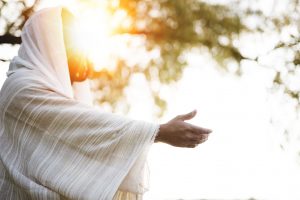
Everything Points to Jesus
As you worship the Lord this Palm Sunday and remember the importance of His willing entry into Jerusalem that week, take a moment to think about the gate He chose to kick off all the events of those final days of His earthly life.
No matter which faith group you follow or what you want to call it, the gate of the triumphant entry describes the very nature of God. Muslim, Jewish, or Christian, perhaps this is where we can all agree. God is truly golden, merciful, eternal, and beautiful.
For Christians, we know He proves His glory through His sacrificial love on the cross five days after Palm Sunday and His triumph over death three days after that. What’s even better is that He continues to offer mercy and salvation to us until He comes again.
Hosanna! Blessed is He who comes in the name of the Lord!
Further Reading

Too often, churches today skip talking about Palm Sunday and move straight to Good Friday and Resurrection Sunday. In this article, I explain why it’s important we remember Palm Sunday and how Jesus’ triumphant entry fulfills Biblical prophecy.
Jesus’ Last Weekend: Remembering Palm Sunday
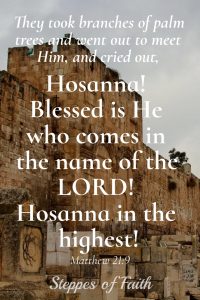
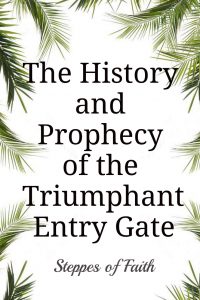
Thanks for writing this… the gates are very important in history and current times as we await HIS soon return. I say this because of many signs like the current plague described in Isaiah 26: 19-21, the book of truth (mostly Daniel 11) and the torahcalendar.com fairly accurate timeline and the 6001st year approaching. thanks.
Hi I am Val Lougheed – I would like to subscribe to your Steps of Faith outreach but can’t seem to get past ‘I am not a robot’ – help! Blessings Val
I first read wikipedia when I was researching the Eastern Gate, and it had some fascinating examples from Jewish and Muslim faiths about what they believed about the gate. It’s incredible how it ties back in to Jesus. Your explanation is very comprehensive! Thank you
The story of the eastern gate is something I have always known my grandmother told me all about it. I am 64 years old. You told I just like my grandmother did. Do they really think they can keep The Lord out ……..